Boerhavia diffusa
Nyctaginaceae
Every time John and George go to the Hobe Sound National Wildlife Refuge calamity strikes. Last time, we got the car stuck in the sand; today it was merely a downpour a mile from the car (parked safely on nice firm pavement). We explored a dirt path immediately behind the seashore dunes, and marveled at the biodiverse lush dune jungle . Trying to compile a list of every plant species present would be a big effort because there are more species than I can count on my fingers and toes. Interestingly, species associated with xeric habits (such as Cacti) are nearly adjacent there to others usually associated with wet feet (such as Fall Panicgrass).
The lion’s share of the biomass is legumes, probably owing to their ability to create nitrogen “fertilizer” on otherwise poor sand: Nickerbean (the dominant species) along with Baybean, Bushbean, Coinvine, Coralbean, Cowpea, an invasive Senna species, and assorted weeds represent the Bean Family. Looking beyond Legumes, especially beautiful were the Yellowtops, Devil Potato, and Bloodberry. But let’s get to the point. A curious little species not rare on sandy soils is Red Spiderling (Boerhavia diffusa).
It’s pretty if you look closely, with Bougainvillea-colored flowers. The coloration is no coincidence, as the two are in the same family.
The Boerhavia flowers actually look like Bougainvillea flowers overall, but a point of clarification: in Bougainvillea the flowers are small (not so different in size from Boerhavia) and white, the purple in Bougainvillea is in the bracts surrounding the flowers.
Garden Four-O-Clocks (Mirabilis) are likewise related with similar pigments, or to be more native-plant-oriented, likewise for Beach “Peanut” (Okenia hypogaea).
- Okenia (JB)
The fruits in B. diffusa have sticky Velcro-hairs, and they do get around, in part with help from migratory birds.
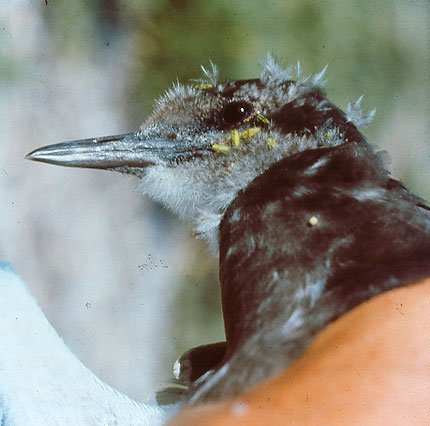
Sooty Tern with Spiderling fruits along for the ride. Sooty Terns are sea-faring birds. (By botanist Sherwin Carlquist)
Variably defined, B. diffusa, or a complex of closely allied species, depending on how you split and lump, is worldwide, including Asia, Africa, Hawaii, Australia, the Caribbean, and the U.S., with the point of origin unclear. The relationships among the different interconnected variants is so unclear that estimates of the number of recognized species in the genus range from 10 to 40. Or, worse, down through botanical history over 200 species names have been applied in Boerhavia. In short, an extremely confusing genus where the species have not read the textbooks concerning species definition.
The plants have taproots, and these have served medicinally, including to prepare laxatives and expectorants. Fact is, Boerhavias have served in many cultures worldwide in more medicinal capacities than Dr. Oz. Alkaloids in the root, including an alkaloid called punaravine, are diueretic and raise the blood pressure. The leaves are salad in some cultures, and the “seeds” have been ground into flour. However, the alkaloids, bioactivity, and probable toxicity say do not eat this plant.
As as fascinating note added post-publication, Paul Rebmann at wildphoto.com (comments below) put the plant together with the Spiderling Plume Moth. Click on the web address below to see flower and pollinator united at Paul’s site! http://www.wildflphoto.com/species.php?k=a&id=300
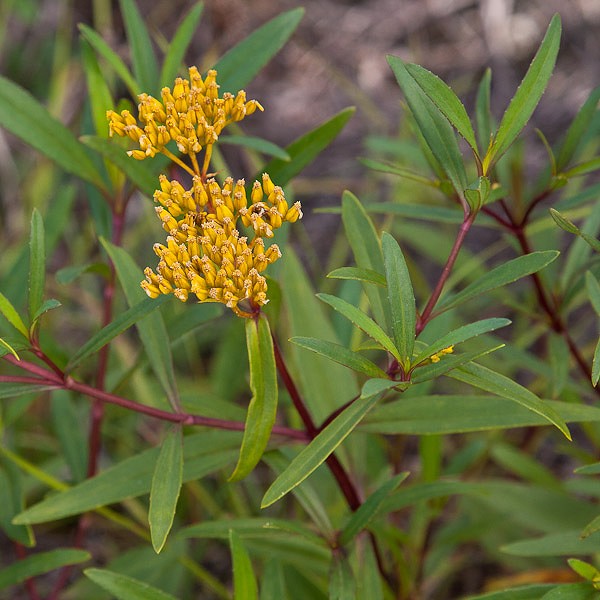
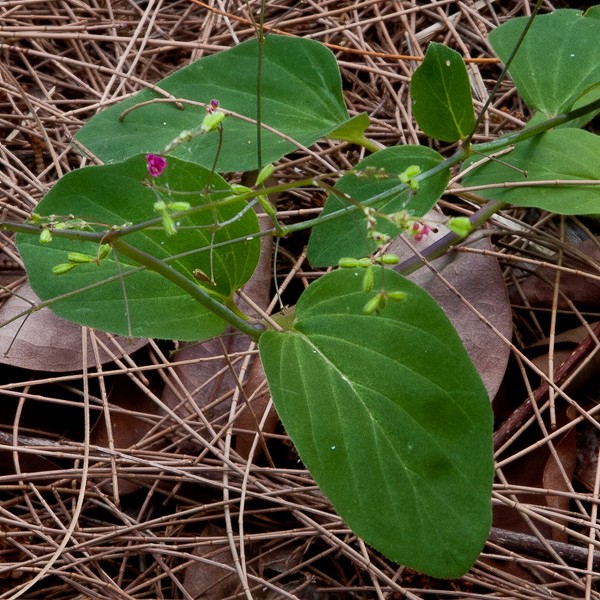
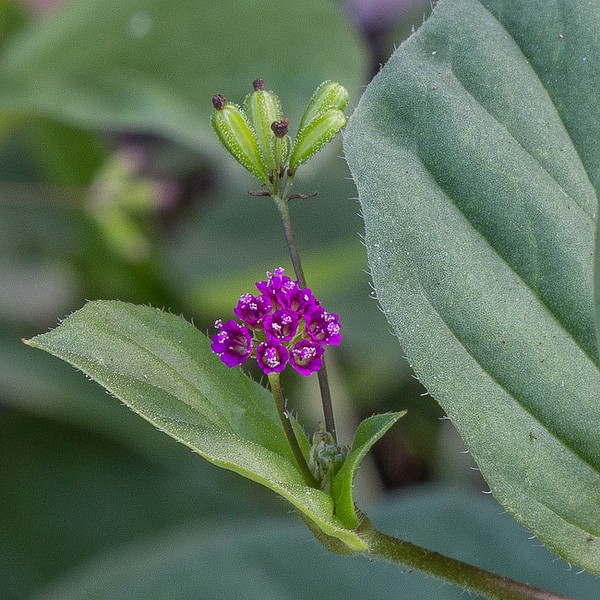
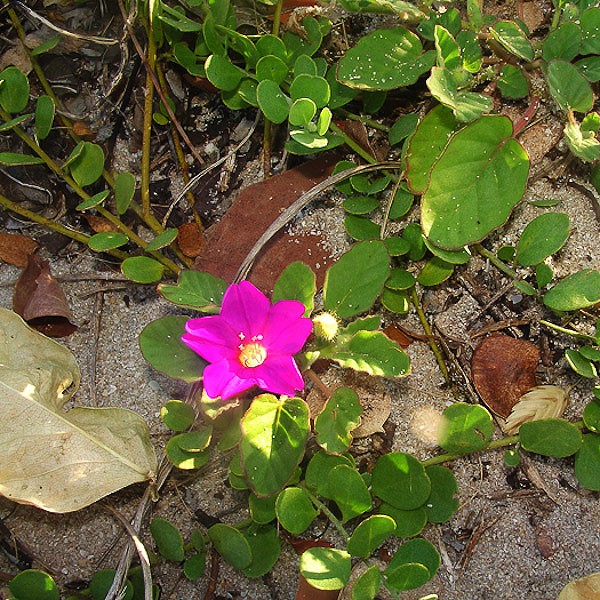
wildflp
August 3, 2013 at 10:03 pm
George,
You have solved a mystery for me. I apparently have red spiderling in my yard (Volusia Co. Beachside) and did not know what it was until I read your post. Is there a particular time of day these flowers tend to be open? I ask because I haven’t been able to catch it when it looked like anything other than buds.
Paul Rebmann
George Rogers
August 3, 2013 at 10:10 pm
Paul, so glad that mystery is cleared up. As to when the flowers open, I have two points of personal experience. The photos in the blog were taken mid-morning last Friday under overcast skies. Also, I encounter the species daily when I walk my dog in an open sandy area near my home late afternoons, and do see it in flower then. You know, given how finicky Four-o-Clocks are about open vs. closed, I would not be surprised if Boerhavia behaves some that way too, but have not really watched enough to know. (Now will pay more attention thanks to you.) Nice owl.
Steve
August 3, 2013 at 10:22 pm
Awesome photos John! This is another one of those plants listed as “native” by some Florida botanists, but it is very ruderal, and I cannot be certain whether I have observed it in any undisturbed habitats. I’m fine with listing certain disturbance loving species as native, but just sayin’…
Regardlng Boerhavia’s edibility, my chickens don’t like it too much (I give them bundles of weeds from the yard), so I’d be careful eating them. I haven’t noticed a time of day for flowers on the plants in my yard, and will be more careful to check it out.
George Rogers
August 4, 2013 at 1:03 pm
Well, there are many cases in Flora and elsewhere where the question of “native” vs. “not native” is not possible to know, and/or hinges on one’s own definition of native, and/or relates to species definitions. Often arbitrary or speculative, even if we did have a time machine.
Weedy plants do get around, and sometimes the movement is a hopelessly intertwined tangle of human-mediated and natural. If Global Warming made it possible for a species to survive here, and yet the pods floated to our shores “naturally” is it native? If it arrived from Cuba in the bilge of a canoe in the year 900 is it native? If the bird that brought the seeds from afar is a native bird, but dropped them while eating Brazilian Pepper berries, is the introduction native? If ocean currents and the manure from visiting polo horses brought the seeds separately, is the plant native?
I’m not sure that restriction to or preference for disturbed habitats shouts “not native,” as many native species are natural weeds, ecological pioneers, and adapted for disturbance. Species that like maritime habitats make good examples. Acknowledging that “native” is often impossible to decide and sometimes iffy to define, the Sooty Tern would like to chime in now that, “I go all around the world crossing the oceans with ease, and Sherwin Carlquist shot a photo of the fruits riding around my eye…With my help, and who knows how else, the plants are on uninhabited oceanic islands, so thank you very much, I have not needed human help to disperse Boerhavia over long distances spanning long time periods.” Based on that testimony, I could not find the accused guilty beyond the shadow of a doubt of being non-native.
As far as edibility goes, I wish I had not fooled around with silly Pig-Latin on a safety point. When a plant contains bioactive alkaloids, I don’t know about chickens, it is not for human consumption. In short, don’t eat it. (But some people do—yes, and some people drive drunk, or come from societies where the average lifespan is 40, or have medical troubles of undetermined origin, or ride unicycles.)
Mary Hart
August 5, 2013 at 3:31 am
I, too, must compliment John on his great photography in all his and George’s – reminds me of an avid nature photographer on my favourite UK nature reserve. He was lying flat to snap a broomrape, when he realised that an adder (UKs only venemous snake) was beside his arm! Afterwards all anyone asked was “Did you get the picture?” ……
George Rogers
August 5, 2013 at 7:51 am
Perhaps it was a little out of focus due to “field conditions.”
wildflp
August 5, 2013 at 9:15 pm
I went out first thing Sunday morning and found 2 flowers open out of the several dozen of the inflorescences in various stages from bud to past seed. As I was photographing them, a tiny plume moth landed and began feeding from the flower. I will post these soon at wildflphoto.com and it will probably be the next featured photo. I may have missed some flowers being open because they are so tiny, but I have also been checking mostly late in the day, and then, even when looking closely, I am not finding any open.
Your blog is always very informative, and I am glad that I found it.
Paul
George Rogers
August 6, 2013 at 7:53 am
I can hardly wait to see that picture and will make a point of spotting it at your site. Been wondering what visits those flowers. That pollination pattern where the plant keeps presenting a few flowers at a time for an extended period promotes “traplining” pollinators. (As opposed to “big bang” flowering.) Looks you are at the cutting edge of getting-to-know Boerhavia.
By the way, Spigelia marilandica is an old favorite species of mine—enjoyed your photo of it. Brought back memories.
wildflp
August 8, 2013 at 10:12 pm
Image my surprise as I am browsing through bugguide.net and discover the little moth is a spiderling plume moth, now the featured photo at wildflphoto.com
Paul
George Rogers
August 9, 2013 at 7:49 am
Well, I’ll be danged! Nice work. I inserted a link to your discovery into the post—see the final paragraph.
Steve
August 12, 2013 at 10:01 am
Thanks for elaborating and clarify the issue of nativity & edibility with plants.